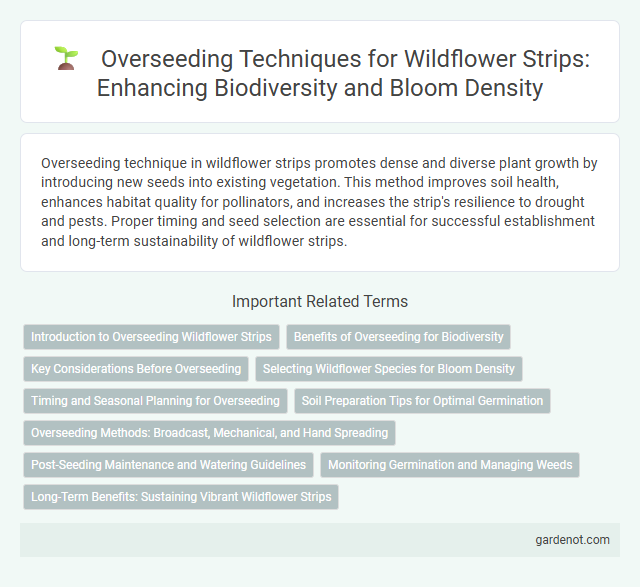Overseeding technique in wildflower strips promotes dense and diverse plant growth by introducing new seeds into existing vegetation. This method improves soil health, enhances habitat quality for pollinators, and increases the strip's resilience to drought and pests. Proper timing and seed selection are essential for successful establishment and long-term sustainability of wildflower strips.
Introduction to Overseeding Wildflower Strips
Overseeding wildflower strips enhances plant diversity and density by introducing new seeds into existing vegetation. This technique promotes ecosystem resilience, improves soil health, and extends flowering periods, benefiting pollinators and wildlife. Proper seed selection and timing are critical to ensure successful germination and establishment within the wildflower strip.
Benefits of Overseeding for Biodiversity
Overseeding wildflower strips enhances biodiversity by increasing plant species diversity, which supports a wider range of pollinators and beneficial insects. This technique helps maintain soil health and resilience, promoting a balanced ecosystem. Diverse wildflower populations contribute to habitat connectivity and food resources for birds and other wildlife.
Key Considerations Before Overseeding
Overseeding a wildflower strip requires careful soil preparation to ensure seed-to-soil contact and optimal germination rates. Selecting native wildflower species suited to local climate and soil conditions maximizes biodiversity and long-term strip health. Proper timing, ideally in early fall or spring, aligns with natural growth cycles and minimizes competition from invasive weeds.
Selecting Wildflower Species for Bloom Density
Selecting wildflower species for overseeding should prioritize native plants known for high bloom density, such as purple coneflower (Echinacea purpurea), black-eyed Susan (Rudbeckia hirta), and wild bergamot (Monarda fistulosa). Using a diverse seed mix containing early, mid, and late bloomers ensures continuous floral coverage throughout the growing season. Optimal bloom density is achieved by matching species to local soil, sunlight, and moisture conditions, enhancing pollinator attraction and ecosystem resilience.
Timing and Seasonal Planning for Overseeding
Optimal timing for overseeding wildflower strips occurs in early fall or early spring, aligning with moderate soil temperatures around 50-65degF to maximize seed germination. Seasonal planning should consider local climate patterns, rainfall distribution, and the dormant period of existing flora to ensure established plants are not outcompeted. Proper timing enhances seed-to-soil contact and increases the likelihood of diverse species establishment, resulting in a resilient and vibrant wildflower habitat.
Soil Preparation Tips for Optimal Germination
Effective soil preparation is crucial for overseeding wildflower strips to ensure optimal germination rates. Loosen the soil to a depth of at least 2-3 inches to improve seed-to-soil contact and enhance moisture retention. Remove existing weeds and debris, and consider lightly raking the area to create a fine, level seedbed that promotes consistent germination and healthy root development.
Overseeding Methods: Broadcast, Mechanical, and Hand Spreading
Overseeding wildflower strips enhances plant diversity and resilience through precise seed distribution methods. Broadcast overseeding disperses seeds uniformly across the soil surface using specialized spreaders, promoting even germination. Mechanical overseeding employs machinery to embed seeds into the soil, improving seed-to-soil contact, while hand spreading allows targeted placement in smaller or irregular areas, ensuring optimal coverage in wildflower restoration projects.
Post-Seeding Maintenance and Watering Guidelines
Maintaining a wildflower strip after overseeding requires careful post-seeding care to ensure successful germination and growth. Water the newly seeded area lightly but consistently, aiming for moist soil without waterlogging, typically applying 0.25 inches of water daily for the first two weeks. Limit foot traffic and mow only after wildflowers reach 6-8 inches tall to promote healthy establishment and long-term biodiversity.
Monitoring Germination and Managing Weeds
Monitoring germination in overseeding wildflower strips involves regularly inspecting seedling emergence to ensure optimal coverage and identifying areas requiring reseeding. Effective weed management integrates timely removal of invasive species and selective herbicide application to prevent competition with young wildflowers. Maintaining a consistent monitoring schedule enhances seedling survival rates and supports the establishment of a diverse, thriving wildflower habitat.
Long-Term Benefits: Sustaining Vibrant Wildflower Strips
Overseeding wildflower strips enhances biodiversity by introducing a diverse mix of native species that strengthen ecosystem resilience and support pollinator populations year after year. This technique promotes soil health through improved nutrient cycling and root structure, ensuring the wildflower strip remains lush and vibrant across seasons. Consistent overseeding mitigates plant disease and weed invasion, securing the long-term sustainability and visual appeal of the landscape.
Overseeding technique Infographic

 gardenot.com
gardenot.com